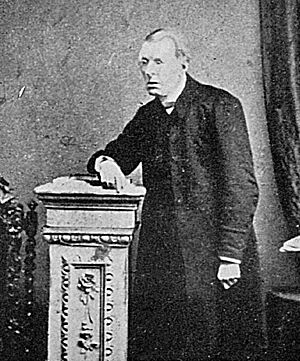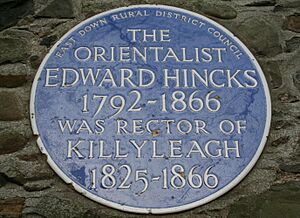Edward Hincks facts for kids
Edward Hincks (born August 19, 1792 – died December 3, 1866) was an Irish church leader. He is best known for being an amazing expert in ancient languages. He helped figure out cuneiform, a very old writing system from Mesopotamia. Cuneiform was used by people like the Babylonians and Assyrians.
Edward Hincks was one of three main experts who cracked the code of cuneiform. These three men were sometimes called the "holy trinity of cuneiform." The others were Sir Henry Creswicke Rawlinson and Jules Oppert.
Early Life and Education
Edward Hincks was born in Cork, Ireland, on August 19, 1792. He was the oldest son of Rev. Thomas Dix Hincks. His father was a well-known Protestant minister and a scholar of ancient languages and nature. Edward had two younger brothers who also became famous. His brother Sir Francis Hincks became an important politician in Canada. His other brother, William Hincks, became a professor of Natural History.
Edward learned a lot at home from his father. He also went to Midleton College. Later, he studied at Trinity College Dublin. He was a very smart student. In 1810, he was chosen as a Scholar of the College. In 1812, he won a special award for his skills in mathematics.
In 1813, Edward Hincks became a Fellow of Trinity College. This meant he was a senior member of the college staff. Four years later, he earned his Master of Arts degree. In 1819, he became the leader of a church in Ardtrea, County Tyrone. This was a good job, but it was also quite lonely for him.
So, in 1826, he moved to lead the church in Killyleagh, County Down. He stayed there for the rest of his life. His church duties were not too demanding. This gave him plenty of time to study ancient languages, which he loved.
Cracking Ancient Codes
Edward Hincks first became very interested in the writing of ancient Egypt. This writing system is called hieroglyphs. By 1823, a French scholar named Jean-Francois Champollion had already figured out how to read hieroglyphs. But Hincks still made his own important discoveries. These discoveries showed that he was an expert in ancient languages.
In the 1830s, Hincks started to study Old Persian cuneiform. This was a type of cuneiform used by ancient Persian emperors for their grand writings. He worked on his own, separate from another leading expert, Sir Henry Creswicke Rawlinson. Hincks realized that this writing system used syllables. He also correctly figured out the sounds of the Persian vowels.
In 1835, Hincks helped unroll the mummified body of a woman named Takabuti. This happened at the Belfast Natural History Society. Hincks read the Egyptian hieroglyphs on her mummy. The hieroglyphs told them that she was the mistress of a great house.
He also published papers on how to figure out the dates of ancient Egyptian history. He helped connect different Egyptian rulers and time periods.
Deciphering Cuneiform
Edward Hincks' biggest achievement was figuring out the ancient language and writing of Babylon and Assyria. This language is called Akkadian cuneiform. He might not have focused on this new area if it weren't for an exciting discovery in 1842.
In 1842, an archaeologist named Paul Émile Botta found the remains of the ancient city of Nineveh. This city was the capital of the Assyrian Empire. Botta and others, like Austen Henry Layard, found many treasures there. One of the most amazing finds was the library of Assurbanipal. This royal library had tens of thousands of clay tablets. These tablets were covered in a strange, unreadable writing called cuneiform.
Three men played a key role in figuring out this writing. They were Hincks, Rawlinson, and a young scholar named Jules Oppert. Hincks correctly guessed that cuneiform was invented by one of the earliest civilizations in Mesopotamia. These people were later identified as the Sumerians. They then passed this writing system on to later groups like the Babylonians and Assyrians. In 1848, Hincks received a special award for his work.
By 1850, Hincks had made important discoveries about Assyro-Babylonian cuneiform. He believed that the writing mostly used syllables. These syllables could be simple, like "ab" or "ki." They could also be more complex, like "mur." He also found that cuneiform signs could have many different meanings. The meaning depended on how the sign was used.
Hincks had also identified many special signs called "determinatives." He correctly figured out what they meant. But not everyone believed the claims made by Hincks and his colleagues. Some experts even thought they were just making up meanings for the signs.
In 1857, an English scholar named William Henry Fox Talbot had an idea. He suggested giving an unread cuneiform text to several different experts. If they all translated it similarly, working on their own, it would prove their claims.
It so happened that Talbot, Hincks, Rawlinson, and Oppert were all in London in 1857. Edwin Norris, who worked for the Royal Asiatic Society, gave each of them a copy of a new inscription. This inscription was from the time of the Assyrian emperor Tiglath-Pileser I. A group of experts then looked at all the translations to see how accurate they were.
The translations from the four scholars were very similar in all the main parts. Of course, there were a few small differences. Talbot, who was less experienced, made some mistakes. Oppert's translation had a few unclear parts because he wasn't as familiar with English. But Hincks' and Rawlinson's translations were almost exactly the same. The experts were satisfied. They declared that cuneiform had truly been figured out!
Reverend Edward Hincks spent the rest of his life studying cuneiform. He made even more important contributions to understanding it. He passed away at his home in Killyleagh on December 3, 1866, at age 74. He left behind his wife and four daughters.



